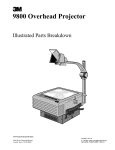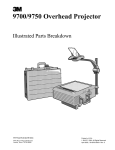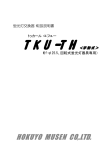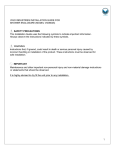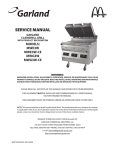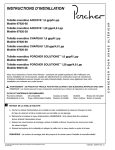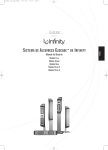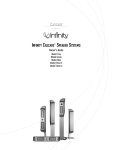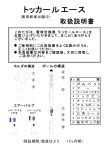Download 3M Projector 2100 Owner's Manual
Transcript
Model 2100 (4100) Overhead Projector Service Manual (Order the M2100 Illustrated Parts Breakdown separately - Stock # 78-6970-4936-5) 78-6970-1335-3 Visual Systems Division 3M Austin CenterBuilding A145-5N-01 Austin, TX 78726-9000 9/92 MODEL 2100 OVERHEAD PROJECTOR TABLE OF CONTENTS Technical Support Hotline - 1-800-328-1371 (U.S. & Canada) TITLE PAGE NUMBER Section 1 - Introduction ................................................................................. 1-1 Specifications .............................................................................. 1-1 Principles of Operation................................................................ 1-3 - Optics ....................................................................................... 1-3 - Cooling ..................................................................................... 1-3 Section 2 - Operation and Maintenance ........................................................ 2-1 Set Up Procedure ....................................................................... 2-1 Lamp Management System ........................................................ 2-3 Cleaning ...................................................................................... 2-4 - Cleaning Stage and Fresnel Lens ............................................. 2-4 - Mirrors ...................................................................................... 2-4 Lubrication .................................................................................. 2-5 Section 3 - Troubleshooting ........................................................................... 3-1 Section 4 - Adjustments ................................................................................ 4-1 General ....................................................................................... 4-1 Tools Required ............................................................................ 4-1 Projector Check-out Facilities ...................................................... 4-1 Optical Alignment ........................................................................ 4-3 - Square Image ........................................................................... 4-3 - Focus Mechanism ..................................................................... 4-4 - Aligning the Fresnel Lens ......................................................... 4-4 Color Tuning Cable...................................................................... 4-5 Post (Folding) .............................................................................. 4-6 Lampchanger Cable .................................................................... 4-6 Section 5 - Electrical Diagrams ..................................................................... 5-1 Section 6 - Disassembly/Re-assembly .......................................................... 6-1 Projection Head Assembly (Doublet) .......................................... 6-1 Projection Head Assembly (Triplet) ............................................. 6-1 Top Cover Assembly ................................................................... 6-1 Fresnel Lens ............................................................................... 6-1 Stage Glass ................................................................................ 6-2 Focusing Assembly ..................................................................... 6-2 Condenser Lens ......................................................................... 6-3 Section 7 - Illustrated Parts Breakdown......................................................... 7-1 (Published separately - Stock # 78-6970-4936-5) 9/92 MODEL 2100 OVERHEAD PROJECTOR SECTION 1 INTRODUCTION This service manual contains servicing instruction, troubleshooting guide, adjustments, electrical diagrams, assembly/dis-assembly of parts and the illustrated parts list. ANGULAR BODY (2130/4130, 2140/4140, 2160, 2170) ROUND BODY (2150/4150, 2180) SPECIFICATIONS Physical Width Depth Height Weight - 15.25" 20.25" 26.25" 7.75" 30.75" 22 lbs. 25 lbs. (387mm) (514mm) (667mm) (197mm) (781mm) (10.0 Kg) (11.3 Kg) (Post in upright position) (Post in folded position) (Body) (Maximum, top of head) 2180 2130, 2140, 2150, 2160, 2170, 4130, 4140, 4150 9/92 1-1 MODEL 2100 OVERHEAD PROJECTOR 1-2 9/92 MODEL 2100 OVERHEAD PROJECTOR Electrical Voltage Frequency Current Rating Power Cord Agency Approval Fuse 2130/2140/2150 4130/4140/41 50 120/127/VAC 60HZ 3.0 Amps 14-1/2' (4.4mm) UL, CSA ------- 2160/2170/2180 2160/2170/2180 100VAC 50/60HZ 3.6 Amps 14-1/2' (4.4mm) ------- 220/230/240VAC 50HZ 1.7 Amps 14-1 /2' (4.4mm) VDE, NEMKO, SETI SEMKO, SEV F4 Amp - 250 Volt F4 Amp - 250 Volt Mechanical Safety interlock: Shuts off power to the projector when the top cover assembly is opened. Safety thermostat: Cuts power to the lamp if the projector exceeds safe operating temperature. Color tuning knob: Allows projector to be easily color tuned for any screen size 1.0m x 1.0m (40" x 40") to 2.8m x 2.8m (110" x 110"). Projection Head Tilt - 0° - 20° (All Heads) Lamp Changer - when lamp burns out, switch to standby lamp. Optical Lamp: ANSI Code FNT, 24 Volt, 275 Watt Lamp Life: 75 Hours 2130/2140/2150 2160/2170/2180 4130/41 40/4150 Illumination: 2000 lumens typical; 2100 lumens typical; 1800 lumens minimum; 1900 lumens minimum; Mirrors: Chassis mirror is second surface high reflective type. (After serial no. 435242) Projection mirror is front surface high reflective type. Head, Projection: Stage: Transmissive Aperture 2130, 2140, 2160, 2170 4130/4140 355mm (14.0" F.L.) Doublet 293mm (11.5" F.L.) Singlet 2130/21 40/2150 4130/41 40/4150 267mm x 267mm (10.5" x 10.5") 2150, 2180 4150 327mm (12.9" F.L.) Triplet - w/focus correction 330mm (13" F.L.) After serial no. 411964 2160/2170/2180 285mm x 285mm (11.2" x 11.2") 9/92 1-2 MODEL 2100 OVERHEAD PROJECTOR PRINCIPLES OF OPERATION The stage glass provides a convenient flat surface for placing transparencies and other materials to be projected. Because the light passes through the stage, these projection materials must be transparent. Optics (See Figure 1-2) The light source for the Overhead Projector is 275 watt, 24 volt, Tungsten Lamp listed as ANSI Code FNT and rated at 75 hours. An external reflector is needed with this lamp. There are two (2) different projection head assemblies available for the projector. One is an Open Triplet Head with focus correction which has a triplet lens and front surface mirror and the second a closed Doublet Head which has one or two condensing lens(es) and a front surface mirror. The projection head is located directly over the center of the Fresnel Lens. The projector is focused by raising or lowering the projection head. Care should be exercised to prevent excessive vibration or jarring of the projector when the lamp is on. The lamp filament becomes more brittle at the operating temperature of the projector and shocks may cause premature failure of the lamp. The glass envelope should not be touched by the fingers when inserting the lamp in the lampholder. Oils on the skin may combine with the glass to form blisters which also will shorten the life of the lamp. The Fresnel lens, located above the lamp and directly beneath the projection stage, is a condensing lens which consists of a series of concentric rings, each of which has a surface curvature similar to that of a thick smooth lens. The Fresnel lens is made of plastic and may be severely damaged if the fan is stopped or the paths of cooling air blocked. Proper alignment and direction of the Fresnel lens is essential in order to maintain the resolution and brightness specifications for the projector. 1-3 Proper alignment of the optical components and a clean machine are essential if the maximum operating capabilities of the overhead projector are to be realized. Cleaning and alignment procedures are discussed in Sections 2 and 4 inclusive. Cooling (See Figure 1-3) Cooling of the overhead projector is accomplished by a motor-driven fan located next to the lamp housing. The cooling air enters the projector through opening “A” and exits through opening “B.” (See Figure 1-3) It’s important that the flow of cooling air not be restricted either by placing projector too close to a wall (about one foot clearance is necessary) or by leaving foreign objects inside the projector. 9/92 MODEL 2100 OVERHEAD PROJECTOR SECTION 2 - OPERATION AND MAINTENANCE SET UP PROCEDURE 1 . Connect the power cord to a properly grounded electrical outlet. (Electrical requirements are listed on the serial plate located under the base of the projector.) 2. Place the projector on a level surface and turn the projector on by pushing down on the ON/OFF switch. CAUTION! Do not look in the front projection lens when lamp is on. 3. Adjust the image to the screen elevation by moving the front projection lens upward or downward on the DOUBLET HEAD ASSEMBLY and the mirror on the TRIPLET HEAD ASSEMBLY. (See Figure 2-2) 4. Place a transparency on the stage glass and focus the projected image by rotating the Focus Knob. (See Figure 2-3) 5. To maintain top to bottom focus when the screen is not perpendicular to the projected image, engage the FOCUS CORRECTION LEVER located on the under side of the TRIPLET HEAD ASSEMBLY using the following procedure: NOTE 9/92 THE PROJECTION SCREEN MUST BE IN THE VERTICAL POSITION. 2-1 MODEL 2100 OVERHEAD PROJECTOR Correct any horizontal keystoning by moving the projector until it is perpendicular with the screen. A. Pull the mirror down as the FOCUS CORRECTION LEVER is pushed to the rear of the head assembly. B. Raise the mirror back to the original position and refocus using the FOCUS KNOB. 6. Rotate the Color Tuning Knob until the projected image is free of any yellow or blue corners. - To remove blue corners, rotate the dial counterclockwise. - To remove yellow corners, rotate the dial clockwise. 7. Correct any vertical keystoning by tilting the screen until it is perpendicular to the light beam axis. 2-2 9/92 MODEL 2100 OVERHEAD PROJECTOR LAMP MANAGEMENT SYSTEM (Lamp Indicator) Pertains only to models equipped with lamp indicators. (2130/4130 - No holes, opaque) NOTE When the projector is turned on, the red X will momentarily light. This is a characteristic of the projector. The Lamp Indicator indicates status of projection lamp as defined on the following labels: METHOD 1 A red X will appear on the lamp symbol when that lamp is burned out. Switch to the standby lamp. The X will continue to light until the defective lamp is changed. METHOD 2 A red X will appear between the two lamp symbols when a lamp is burned out. Switch to the standby lamp. The X will continue to light until the defective lamp is changed. NOTE The Overhead Projector must remain on for 2 to 3 minutes after a lamp burns out. This will allow the fan to cool the burned-out lamp and prevent burned fingers. Unplug the unit before replacing the lamp. 9/92 2-3 MODEL 2100 OVERHEAD PROJECTOR the hinge pin is out of the hole. Slide the complete Top Cover Assembly in the opposite direction to release the second hinge and lift up and out (See Figure). CLEANING The optical components of the overhead projector require occasional cleaning to remove the dust and oil which tends to accumulate and absorb light. 3M Brand Lens Cleaner (Part No. 78-6969-7086-6) is recommended. A small amount of mild detergent in water will serve as a substitute. Use soft, lint-free cloths, one to apply the solution and another for drying. NOTE Never use paper lens tissues on projection lenses as they may damage the lens. Cleaning Stage Glass and Fresnel Lens When cleaning the underside of the stage glass and the top side of the Fresnel Lens, observe the following steps. 1. Pull the Release Latch and lift the top cover Top Cover Assembly (See Figure). 2. Remove the Top Cover Assembly by pulling either one of two hinges outward until 3. Loosen the four screws holding the Fresnel Lens in place. NOTE: Do not remove the screws. 4. Turn the retaining clips off to one side. 5. Remove the Fresnel Lens. 6. All surfaces can now be cleaned. 7. Replace all components in reverse order. Mirrors The mirror in the Open Lens Projection Head of all Model 2100 (4100) projectors are front surface mirrors and must NOT be cleaned with a cloth and lens cleaner. Remove any surface dirt on this mirror with a Camel Hair Brush only. Prior to serial number 435242 a front surface type Chassis Mirror was used (clean as above). After serial number 435242, a second surface high reflective type is used and may be cleaned with a soft cloth and lens cleaner. 2-4 9/92 MODEL 2100 OVERHEAD PROJECTOR LUBRICATION As needed and upon new parts installation, lubricate lightly the following area with Anderol No. 757 Grease (3M Part No. 788000-8079-4). For reference on the lubricating points, see the three blow-up parts lists. Lamp Changer Assembly Before S/N 439180 Focus Assembly Folding Post Assembly Lamp Changer Assembly After S/N 439180 9/92 2-5 MODEL 2100 OVERHEAD PROJECTOR SECTION 3 - TROUBLESHOOTING SYMPTOM Projected image is: a. Corners of projected image appear red (brown) or blue. CHECK - b. Top, bottom, or sides of projected image are not focused. - c. Not as bright as it should be. - Focus mechanism slips or is too tight. Lamp does not energize, but fan motor does energize. - Is lamp of proper type? (See label on underside of Top Cover) Is lamp properly seated down in its socket and vertical? If unit is equipped with a lamp changer, is changer lever fully seated in the number one position? Are any of the optics components noticeably "knocked" out of alignment? - Is lamp of proper type? (See label on underside of Top Cover) Is lamp properly seated down in its socket and vertical? If unit is equipped with a lamp changer, is changer lever fully seated in the number one position? Has another FNT lamp been tried? - Focus tension screw needs adjustment - Is lamp burned out? Is lamp of proper type? (See label on underside of top cover) Is lamp properly seated down in its socket and vertical? If unit is equipped with a lamp changer, is changer lever fully seated in the number one position? - Neither lamp nor fan motor energizes. Is lamp of proper type? (See label on underside of top cover) Is lamp properly seated down in its socket and vertical? If unit is equipped with a lamp changer, is changer lever fully seated in the number one position? - - - CAUSE/SOLUTIONS Is power cord plugged into electrical outlet? Is outlet supplying power to projector? - - - Adjust optics components (requires realignment of optics). Lamp not seated. Reflector Condenser Replace lamp. Damaged or misadjusted optics components (requires realignment of optics). Corroded wiring connection. Wrong lamp on Reflector broken/missing - To tighten, turn screw counterclockwise. To loosen, turn clockwise. Add update kit if required. (see next page) - Replace lamp. Replace overheat thermostat. Replace lamp sensing switch (only on projectors equipped with lamp changer). Loose or broken wire connection. Defective power supply. - - 9/92 Damaged or misadjusted optics components (requires realignment of optics). Head "knocked" out of alignment. Adjust Color Tuning On-off switch defective. Defective interlock switch. Loose or broken wire connection. On-off switch out of adjustment. Replace Fuse (if equipped) 3-1 MODEL 2100 OVERHEAD PROJECTOR TROUBLESHOOTING (continued) SYMPTOM Fan motor does not rotate, but lamp does energize. CHECK - Is anything blocking rotation of fan motor? CAUSE/SOLUTIONS - Loose or broken wire connection to motor. Defective fan motor. Both lamps of units with lamp changer energize at once. - Wires crossed and touching? Lamp changer switch? - Defective lamp sensing switch. Projector does not operate when power switch is depressed. - Projector plugged in? Top Cover all the way down? Interlock Switch functioning? Fuse (if so equipped). - Defective power cord. Defective Interlock Switch. Replace Fuse. Broken Wire On dual lamp projectors, position of lamp socket does not change when lamp changer control is moved. - Loose tension cable. - Tighten cable. (See Section 4, adjustments) Top Cover Assembly does not close completely. - Interlock switch out of alignment? Cover latch movement is restricted? - Align interlock switch. Disconnected or broken latch return spring. High voltage - Install Resistor Kit or replace transformer or change transformer tap. Lamps burn out. Field Kits Available Focus Knob Slipping If the projector is below SN401987, the knob must also be replaced. Resistor Kit (120V) Base Rail Kit (for broken base rails on lamp module) - 78-8054-1613-4 78-8054-1614-2 Lt. Grey Charcoal 78-8054-1315-6 78-8054-1443-6 78-8054-1615-9 Tech Service In the U.S & Canada Technical Support Hotline - 1-800-328-1371 7:30 - 5:30 CST 3-2 9/92 MODEL 2100 OVERHEAD PROJECTOR SECTION 4 ADJUSTMENTS GENERAL The following section describes the adjustments that will be necessary to service the Model 2100 (4100) Overhead Projectors. TOOLS REQUIRED A. B. C. D. E. F. Screwdriver (standard & phillips) Wrench, open end Pliers, standard Pliers, grip ring Square Torx Driver, #T-15 (for removal of stage glass) 3M Part Number 26-1005-8317-3 Arrangement of Check-out Area PROJECTOR CHECK-OUT FACILITIES Reliable check-out and optical alignment of the overhead projectors can be accomplished only if proper facilities are available. (see Figure) This requires a permanent viewing screen and test stand in the dealer’s shop, thus enabling high check-out standards to be established and maintained. Service personnel will also find that the use of permanent test facilities will assure a better check-out job in considerably less time than otherwise would be required. Only two low-cost items are required to provide proper check-out facilities: a test viewing screen, 60 by 60 inches, with a flat (nonreflective) white surface; and a bench or test stand permanently located about 8 feet from the screen. The screen should be vertical and can most easily be provided by applying a flat white paint to a 60 by 60 inch area of a smooth wall. If a smooth wall is not available, a piece of wallboard painted flat white, or a white window shade of the proper size, can be mounted in the selected area. The test stand should be high enough to provide easy access to all parts of the Overhead Projector when the projector is placed on the stand for check-out. An electrical outlet and a switch should be built into the test stand to facilitate making electrical connections to the projector. The following steps provide a simple procedure for setting up the permanent test facilities. It is particularly important that the projector be perfectly square with the viewing screen in order to eliminate the possibility of vertical or horizontal keystoning. Even the slightest keystoning will result in unequal focusing of the projected image at the four corners, and will especially affect resolution readings. Therefore, several of the following steps involve squaring the projected light with the screen. Permanently locating the test stand and viewing screen will assure that the proper relationship, once established, does not change. 9/92 (Continued on the next page) 4-1 MODEL 2100 OVERHEAD PROJECTOR 1. Select a 60 by 60 inch, smooth area on one wall. Place a sturdy bench or test stand about 8 feet from this wall area. Position the Overhead Projector on the test stand so that it points toward the wall. 2. Measure the vertical distance from the floor to the center of the front projection lens. Following a floor or ceiling line from the projector to the wall, make a mark on the wall the same distance from the floor. 4. Using the mark on the wall as a base point, measure 30 inches up, down, to the left and to the right. Mark the edges of the resultant 60-inch square, and paint the enclosed area a flat white, or cover the area with a window shade, wallboard or other substitute viewing screen. 5. Turn the projector on and focus an image on the screen. Move the projector forward or backward, maintaining the image in focus at all times, until the projected light just fills the 60 by 60 inch screen. Be sure the image is in focus. Locating Center of Projection Area NOTE If floor or ceiling lines are not available, stretch a cord or string from the projection lens to the wall, and use a carpenter’s square or other square object to find the point at which the cord is perfectly perpendicular to the wall. 3. Mark the position of the stand on the floor and the projector on the stand so that the perpendicular relationship of the line from the projection lens to the wall is not lost while making subsequent adjustments . 4-2 9/92 Correct Tilt of Projector MODEL 2100 OVERHEAD PROJECTOR OPTICAL ALIGNMENT Proper alignment of the optical system is essential for good resolution and uniform illumination. Poor resolution in one corner and either red or blue in the corners of the projected image are indications of poor alignment. The following components should be checked and adjusted if necessary before aligning the overhead projector. D. To square the image on the Triplet Head, remove the two Top Shroud screws and lift off the Top Shroud. Follow the same procedure as used on the Doublet Head to complete adjustment. Replace the Top Shroud. SQUARE IMAGE A. B. C. Set projector on a level table. Project an image onto a screen or wall. Axis of beam must be perpendicular to projection surface. Check to see that side of projected image are vertical. If the image is not square, remove CAP and loosen the three (3) Head Fastening Screws (Doublet Head), and move the projection head either to the left or right, forward or backward. When image is square, tighten the center top screw first, then the two bottom screws. (See Figure) 9/92 4-3 MODEL 2100 OVERHEAD PROJECTOR FOCUS MECHANISM ALIGNING THE FRESNEL LENS If the projection head does not hold its focus position, you must adjust focus knob tension or add focus kit (78-8054-1613-4 (gray), 78-80541614-2 (charcoal). To adjust: Turn the Tension Screw counterclockwise to tighten focus assembly. Turn clockwise if binding occurs. When replacing the Fresnel Lens, use the following procedure: A. Remove the Top Cover Assembly. (See Section 2 - Cleaning Stage Glass and Fresnel Lens, page 2-3) B. Place the Top Cover Assembly upside down on a flat, clean surface. C. With the four (4) corner screws loosened, stretch two rubber bands between diagonally opposite screws, forming an "X" pattern. (See Figure) D. Center circle of Fresnel Lens should exactly coincide with center of "X". E. After centering, remove rubber bands one at a time and retighten corner screws. NOTE Refocus the projector each time an adjustment is made. Aligning the Fresnel Lens 4-4 9/92 MODEL 2100 OVERHEAD PROJECTOR COLOR TUNING CABLE COLOR TUNING CABLE (Before Serial Number 422868) (After Serial Number 422868) No adjustment. NOTE Tension in cable should be 3/16" maximum. A. Raise the Top Cover Assembly by pulling the Release Latch and lift up. (See Figure) B. Turn the Color Tuning Knob clockwise to the maximum. While holding the Cable Screw, loosen the Cable Nut. Using pliers, pull the slack out of the cable. Retighten Cable Nut and Screw. (See Figure) C. D. 9/92 4-5 MODEL 2100 OVERHEAD PROJECTOR POST (FOLDING) LAMPCHANGER CABLE If POST is not perpendicular to the body of the projector, proceed with the following steps using Figures below as reference: 1. Loosen SET SCREW. 2. Put a square on the body of the projector and against the POST> 3. Turn the CAM clockwise to adjust POST. 4. Re-tighten SET SCREW. NOTE Tension on cable should be a maximum of 3/16". A. B. C. NOTE Hold the Cable Nuts (2) with wrench and loosen the Cable Screws (2). Move the screws with nuts outward to tighten cable. Retighten screws with nuts after adjustment is made. (See Figure) POST SHOULD FOLD DOWN WITHOUT TOO MUCH FORCE. 3. Bend down the appropriate LOCKING TAB. Before Serial Number 422868 On projectors after serial number 422868, there is no cable adjustment. 4-6 9/92 9/92 9/92 9/92 9/92 9/92 9/92 9/92 9/92 MODEL 2100 OVERHEAD PROJECTOR SECTION 6 DISASSEMBLY/RE-ASSEMBLY PROJECTION HEAD ASSEMBLY (DOUBLET) TOP COVER ASSEMBLY 1. To disassemble Head Assembly from Head Support Bracket: A. Remove Screw Cap from Top Shroud. B. Remove the three screws (“A”). C. Slide the Head Assembly off Support Bracket. 1. Raise the Top Cover Assembly by pulling the Release Lever and lifting up. 2. Using both hands, pull either one of the two hinges outward until the hinge pin is out of the hole. Slide the complete TOP COVER ASSEMBLY in the opposite direction to release the second hinge and lift up and out. FRESNEL LENS 2. To disassemble Head Assembly from Head Support Bracket: A. Remove the two screws (“A”). B. Lift the Top Shroud off assembly. C. Remove the three screws (“B”). D. Slide the Head Assembly off Support Bracket. 1. Remove Top Cover Assembly. (See Figure above) 2. Loosen the four (4) screws holding the four (4) corner clips and lens. DO NOT REMOVE SCREWS. Turn clips to side and remove lens. NOTE When replacing the Fresnel Lens, make certain the bow in the lens is in the convex (upward) position when projector is upright. See Section 4, page 4-4, for proper alignment of Fresnel Lens. 9/92 6-1 MODEL 2100 OVERHEAD PROJECTOR STAGE GLASS FOCUSING ASSEMBLY 1. Remove Top Cover Assembly.(See page 61) 2. Remove the Fresnel Lens. (See page 6-1) 3. Remove the six (6) tamper proof screws using a T15 Torx Driver. (3M Part Number 26-1005-8317-3) 4. Remove the MASK (black frame) and Stage Glass. 5. To reassemble, make certain the beveled edges on the Stage Glass are facing down and the 3M logo is in the lower left front corner. (2140/2150 only, 2130 does not have logo) 1 Remove knob. 2. Before disassembling, turn Adjusting Screw clockwise to loosen assembly. 3. Remove the four “A” screws and cover. (All internal parts are now exposed.) 4. Before re-assembling, turn adjusting screw counterclockwise. (This procedure makes re-assembly easier.) 5. After re-assembly is completed, readjust the focus tension. NOTE This drawing of Stage is up side down. 6. Reassemble MASK and Fresnel Lens in reverse order as noted above. 6-2 9/92 MODEL 2100 OVERHEAD PROJECTOR How to remove and install the condenser lens (when equipped) Caution! Wear safety glasses when removing lens. .020 Feeler Gage .020 to .030 Gap after installation Tab Illustration A Illustration B 1. Insert a Pin Punch or Drill Rod into the hole in the Tab (see illustration A) 2. Release the lens by bending the Tab. 3. Install the new lens and bend the Tab back into place. Caution! Do not overtighten the tab. The lens must have enough clearance for expansion. There should be a .20 to .30 gap between the lens and lens bracket (Illustration B). Caution! Be careful not to scratch or chip the lens while installing. 9/92 6-3






























